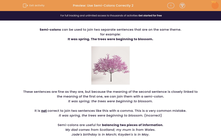Semicolons can be used to join two separate sentences that are on the same theme.
For example:
It was spring. The trees were beginning to blossom.

These sentences are fine as they are, but because the meaning of the second sentence is closely linked to the meaning of the first one, we can join them with a semicolon.
It was spring; the trees were beginning to blossom.
It is not correct to join two sentences like this with a comma. This is a very common mistake.
It was spring, the trees were beginning to blossom. (Incorrect)
Semicolons are useful for balancing two pieces of information.
My dad comes from Scotland; my mum is from Wales.
Jade's birthday is in March; Kayden's is in May.
A capital letter is only needed after a semicolon if the word is a proper noun (e.g. Kayden).
We do not need conjunctions after a semicolon. You can always check that it works by checking that both sides of the semicolon make sense on their own.









